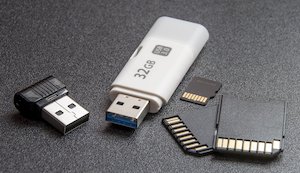 Flash memory is a non-volatile digital storage device. It means that data is stored even when the power supply is switched off. They are used in various electronic devices such as cameras, laptops, smartwatches, and mobile phones for storing user data or software code. This article covers everything you need to know about flash memory, its types, its benefits, how it works, and different types of flash memory.
Flash memory is a non-volatile digital storage device. It means that data is stored even when the power supply is switched off. They are used in various electronic devices such as cameras, laptops, smartwatches, and mobile phones for storing user data or software code. This article covers everything you need to know about flash memory, its types, its benefits, how it works, and different types of flash memory.
What is Flash Memory?
Flash memory is a non-volatile storage device that is used in various electronic devices. The data stored in the flash memory is retained even when the power supply is switched off. It is used in cameras, smartphones, laptops, smartwatches, and other devices. Flash memory is a semiconductor storage device that can be electrically erased and reprogrammed. It is also known as flash storage or flash drive. It has been used as primary or secondary computer storage, as well as in other applications such as storing data in handheld devices, data logging, and computer networking, and in some cases, it has replaced hard disks. Flash memory can be either integrated with the CPU in a single chip (normally embedded) or connected externally as a removable memory device. The term “flash memory” is a bit of a misnomer. The chips used in flash memory devices don’t actually “remember” anything in the way that a computer’s random-access memory (RAM) does.
How Does Flash Memory Work?
Flash memory is a non-volatile storage device that is used in various electronic devices. The data stored in the flash memory is retained even when the power supply is switched off. It is used in cameras, smartphones, laptops, smartwatches, and other devices. Flash memory works based on the “erase-before-write” mechanism. This means that data in the memory is first erased before new data is written on it. It’s important to understand that there is no difference between “erasing” data and “deleting” data. The data is still present in the chip, but it has been removed from the “directory”. This is why you cannot recover deleted data from a flash drive using simple “undelete” software.
Flash Memory Devices
Below are the devices that use flash memory:
- USB Flash Drive: It is used to store data such as images, documents, and software. These devices are small in size and are usually used as a replacement for floppy disks.
- Memory Cards: They are used in mobile phones, digital cameras, and other devices. These cards are available in different storage capacities.
- Solid State Disks: They are used as primary or secondary computer storage. These are faster than traditional hard disks.
- USB Memory Sticks: They can store small data files with audio or video content.
- SSD: They are used in laptops or tablets.
Types of Flash Memory
There are multiple types of flash memory. Each has its features and applications. The most common types of flash memory are:
- NAND Flash Memory: It can be found in USB flash drives, memory cards, and solid-state drives. It is the most commonly used type of flash memory.
- NOR Flash Memory: It is used in Electronically Erasable Programmable Read-Only Memory (EEPROM) and Programmable Logic Devices (PLDs). It is slower than NAND flash; however, it requires less power.
- RRAM (resistive random-access memory): It is used in non-volatile RAM. This type of memory is very fast, but the technology is still in development and the cost of production is high.
- MRAM (magnetoresistive random-access memory): It is similar in operation to RRAM. The data retention is longer and the operation is faster.
Benefits of Flash Memory
The biggest benefit of flash memory is that it can store data even when the power supply is off. The data in a hard drive needs the power to store and retrieve it. Flash memory is also cheaper than a hard drive and more reliable in comparison. The data in flash memory is not easily corrupted and can be erased electronically. The data in a hard drive is easily corrupted, especially if it is not handled properly. Flash memory is also smaller and lighter than a hard disk.
Conclusion
Flash memory is a non-volatile storage device that is used in various electronic devices. The data stored in the flash memory is retained even when the power supply is switched off. With the rapid advancement of technology, flash memory has found extensive use in computers and digital devices. It is cheaper, faster, and lighter than a hard disk.